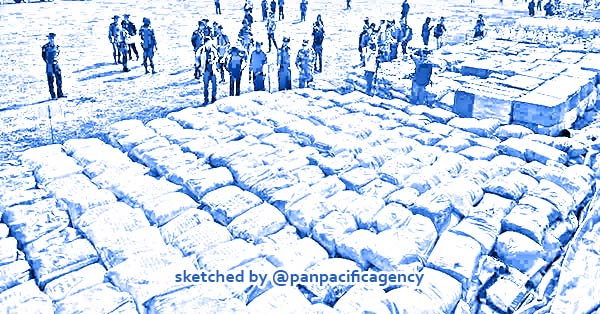Asian narcotic drug-producing markets expand despite pandemic

Foreign military attaches check drugs in a football ground where seized drugs, vehicles, laboratory accessories and precursor chemicals are being displayed to invited military attaches and journalists in Kawangkha on 6 March, 2020. (AFP Photo) Sketched by the Pan Pacific Agency.
YANGON, May 16, 2020, Myanmar Times. The market for synthetic drugs in East and Southeast Asia is growing despite the COVID-19 pandemic, with the price of methamphetamine dropping to its lowest levels as supplies surge, the global anti-drug watch group said, Myanmar Times reported.
The United Nations Office on Drugs and Crime (UNODC) warned in its report released on May 15 that drug production and trafficking in the region have grown unabated and uncontrolled.
The report, “Synthetic Drugs in East and Southeast Asia: Latest Developments and Challenges,” confirmed that the variety and volume of synthetic drugs produced and trafficked in the region increased in the past year.
“It is hard to imagine that organised crime has again managed to expand the drug market, but they have,” said Jeremy Douglas, UNODC representative for Southeast Asia and the Pacific.
He said that while the world has shifted its attention to the COVID-19 pandemic, all indications are that production and trafficking of synthetic drugs and chemicals continue at record levels in the region.
Seizures of meth in East and Southeast Asia have increased year-on-year during the past decade, something not observed in any other part of the world.
Countries in the region confirmed seizures of 115 tonnes of meth in 2019, but that figure does not include any data from China, which has seized an average of nearly 30 tonnes per year in the past five years.
The report highlighted the fact that an increasing supply resulted in meth becoming cheaper, reaching its lowest price in the past decade in East and Southeast Asia.
It noted that despite the declining prices, the purity of Southeast Asian meth remains high, and has even increased in some countries.
“In short, organised crime groups are in a position to provide better quality methamphetamine at much cheaper prices compared to a decade ago, increasing affordability and harm at the same time,” Inshik Sim, a UNODC illicit drugs analyst, said.
The report said meth manufacturing in north-eastern Myanmar – which along with adjacent areas of Laos and Thailand makes up the major narcotic drug-producing region known as the Golden Triangle – had grown significantly in recent years, with record seizures of the drug and some of its precursor chemicals in 2019.
The use of maritime trafficking routes from Myanmar in the Andaman Sea persists, heavily impacting countries in Southeast Asia and the Pacific.
Trafficking from Myanmar to South Asia has evolved, making Bangladesh and India increasingly important destinations for meth outside the Mekong region.
The government of Myanmar has intensified its response, dismantling several meth-manufacturing facilities of unprecedented size.
Between 2018 and 2019, 14 clandestine drug laboratories were seized, according to the UNODC report.
The Tatmadaw (military) launched a weeklong operation in Shan State’s Kutkai township in March and seized over US$100 million worth of drugs and drug-making equipment in three abandoned buildings that were apparently used as a drug laboratory.
According to the Myanmar Police Force Central Committee for Drug Abuse Control, K286.64 billion in narcotic drugs and related chemicals were seized in Shan in 2018, K282.53 billion was seized in 2019, and K42.39 billion worth had been seized as of March 4 this year. The UNODC recognises northern Shan as the epicentre of meth production.
East and Southeast Asia are also witnessing the steady rise of dangerous synthetic opioids. While only three opioids were identified in the illicit drug trade of the region up to 2014, the number increased to 28 in 2019, and seizures are being made in new locations as organised crime continues to push the limits of the business.
“Synthetic opioids like fentanyl and even more potent variations deserve much more attention than they receive in the region,” Douglas said.
“The illicit drug market here is at a tipping point as synthetic opioid production appears to be migrating to places with deep governance problems like the Golden Triangle. Southeast Asia could well become a source of opioids for other parts of the world while these substances get mixed into or displace part of the regional heroin supply.”
Beyond meth and synthetic opioids, the report confirmed that a wide range of synthetic drugs, including ecstasy, ketamine and cannabinoids, are found across the region.
“It is clear that the synthetic drug market in East and Southeast Asia is dynamic and continues to evolve,” according to Justice Tettey, chief of the UNODC laboratory and scientific section.
“Strategies in the region, and in fact elsewhere in the world, should be built with an understanding of the chemical origins of synthetic drugs, which is why forensic and precursor control capacities are critical for countries and the region to effectively respond,” he added.